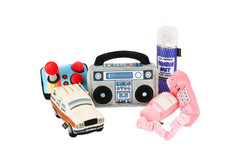Did you know that 65% of pet owners feel their furry friends are like family?
But let's dig a little deeper. In a world where pets create viral moments, from pressing "buttons" to starring in trending TikTok videos, a fascinating question arises: Can dogs and cats truly communicate with us? How do our beloved family pets convey their feelings and affection?
Capturing the essence of your pet's unique personality through a modern pet portrait is just one of the ways pet owners show their love, appreciation, and deep bond with their pets.
It's a subtle language, often hidden in plain sight, and we're about to unravel its secrets.
Understanding Your Pet's Language
When dogs communicate, they often bark, whine, or growl. And it’s important to know what those sounds mean. But more often than not, dogs rely on nonverbal body language. Unfortunately, this can lead to human-dog misunderstandings.
Sometimes, the body language your dog is putting off feels new, like something you haven’t seen from them before. At other times, what you think they are trying to tell you is not their intended message at all.
Reading Dog Body Language: Tips for Effective Communication
Your furry friend may not speak human, but they communicate in their own unique way. To truly understand your dog, you must become fluent in their language. Let’s look at the world of canine body language and provide you with essential tips to bridge the communication gap between you and your four-legged companion.
So, let's start deciphering those tail wags, ear positions, and more!
- Tail Position: A wagging tail isn't always a sign of happiness. A high wag could suggest excitement or alertness, while a low wag could signal submission or uncertainty.
- Ears and Whisker Placement: Forward-pointing ears and relaxed whiskers indicate a content dog. Ears flattened backward may signal fear or aggression.
- Eye Contact and Blinking: A direct, soft gaze shows affection, while prolonged staring can be perceived as challenging. Blinking slowly can be a sign of trust and relaxation.
- Vocal Tone and Pitch: Dogs use a variety of vocalizations. High-pitched whines may indicate excitement or distress, while low growls signify unease or warning.
Now, let's talk about our feline friends.
Cat Communication: Reading the Signs
When your feline friend is relaxed and contented, you might notice them adopting a peaceful, almost drowsy appearance. Their muscles will be relaxed, and their gaze steady, without the usual darting around. Your cat might even invite some affectionate petting or snuggling.
Conversely, when fear strikes, your cat's demeanor can shift dramatically. Picture a cat on Halloween night – their back arching, tail standing on end. In such moments, your kitty may retreat to a hiding spot, steadfastly refusing to emerge. Watch out for signs of distress, such as bared teeth or a menacing hiss, as your cat communicates unease.
- Dilated Pupils: Enlarged pupils indicate arousal or fear.
- Flattened Ears: Pressed-back ears suggest discomfort or agitation.
- Hissing and Growling: Vocalizations like hissing and growling signal distress.
Understanding your cat's body language can help you respond appropriately to their needs and emotions.
Building Trust Through Consistency
Bringing a new pet home is like welcoming a new family member. However, it's essential to remember that, just like us, pets can experience stress, especially when they arrive at their furr-ever home for the first time.
Interestingly, the American Heart Association reports that 95% of pet parents rely on their pets for stress relief, highlighting our powerful bond with our furry companions. But here's the catch: our pets can feel stressed, too. This is where consistent routines and positive reinforcement come into play.
Creating a Solid Routine: A Foundation of Trust
Imagine you're in a new place with unfamiliar faces and routines. It can be overwhelming, right? That's precisely how your new pet might feel. Establishing a consistent daily schedule can be a source of comfort for them. Set regular times for feeding, play, and rest. Predictable routines help your pet know what to expect, reducing their anxiety.
The Power of Positive Reinforcement
Positive reinforcement involves rewarding good behavior and is a game-changer in building trust. When your pet does something you appreciate, like following a command or using the litter box, offer praise, treats, or affection.
This positive feedback teaches your pet what behaviors you find pleasing, reinforcing their trust in you as a reliable and caring owner.
Why Consistency Matters
Consistency is key because it reassures your pet. They start feeling safe when they see that their world is stable and predictable. It's like having a security blanket in the form of a routine. Whether you have a pup learning house rules or a kitty adjusting to a new environment, the more consistent you are, the quicker trust can grow.
Quality Time and Shared Experiences
Spending quality time with your pet is the key to strengthening your bond. Whether you have a playful pup or a cuddly kitty, these shared moments create memories and build trust.
- Planned Playtime: Dedicate time each day to play with your pet. Whether it's a game of fetch, a puzzle toy, or a feathered teaser for your feline friend, engaging in play is a joyful way to connect.
- Shopping Together: Dogs, in particular, love visiting pet-friendly stores. Bring your furry companion along for a shopping trip to pick out new toys or treats. Their tail-wagging excitement is priceless.
- Walking Adventures: Going for a walk benefits both you and your pet. It's exercise and quality time rolled into one. Explore your neighborhood, parks, or trails together.
- Running Errands: Pets love car rides. Take them with you on short errands (where it's safe and allowed), and they'll relish the new sights and smells.
- Local Pet-Friendly Events: Check out local pet-friendly events in your area. From dog-friendly cafes to pet expos, these outings provide opportunities for socialization and adventure.
Capturing Cherished Moments: Creating Timeless Memories with Your Pet
In the hustle and bustle of life, our pets offer a haven of love, joy, and unwavering companionship. It's no wonder that 65% of pet owners consider them family. Just as we cherish our furry friends, they, too, hold a special place in their hearts for us.
From understanding their unique language to building trust through consistency and sharing quality time, we've unlocked the secrets to fostering an unbreakable bond. Our pets become part of our stories and deserve a place of honor in our lives.
So, it's no surprise that many pet owners immortalize their beloved companions with specialized portraits, proudly hanging them in their homes. These portraits remind us daily of the love, trust, and unforgettable moments we share with our pets.
Ultimately, we create a lasting and fulfilling companionship by investing in effective communication, trust-building, and shared moments. This bond is as timeless as the portraits we hang with pride.





